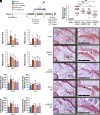A mechanically resilient soft hydrogel improves drug delivery for treating post-traumatic osteoarthritis in physically active joints
- PMID: 40163719
- PMCID: PMC12002200
- DOI: 10.1073/pnas.2409729122
A mechanically resilient soft hydrogel improves drug delivery for treating post-traumatic osteoarthritis in physically active joints
Abstract
Intra-articular delivery of disease-modifying osteoarthritis drugs (DMOADs) is likely to be most effective in the early stages of post-traumatic osteoarthritis (PTOA), when symptoms are minimal, and patients remain physically active. To ensure effective therapy, DMOAD delivery systems therefore must withstand repeated mechanical loading without altering the kinetics of drug release. While soft materials are typically preferred for DMOAD delivery, mechanical loading can compromise their structural integrity and disrupt controlled drug release. In this study, we present a mechanically resilient soft hydrogel that rapidly self-heals under conditions simulating human running while maintaining sustained release of the cathepsin-K inhibitor L-006235, used as a proof-of-concept DMOAD. This hydrogel demonstrated superior performance compared to a previously reported hydrogel designed for intra-articular drug delivery, which, in our study, neither recovered its structure nor maintained drug release under mechanical loading. When injected into mouse knee joints, the hydrogel provided consistent release kinetics of the encapsulated drug in both treadmill-running and nonrunning mice. In a mouse model of severe PTOA exacerbated by treadmill-running, the L-006235 hydrogel significantly reduced cartilage degeneration, whereas the free drug did not. Overall, our data underscore the hydrogel's potential for treating PTOA in physically active patients.
Keywords: disease modification; hydrogel; mechanical loading; osteoarthritis.
Conflict of interest statement
Competing interests statement:J.M.K. has been a paid consultant and or equity holder for multiple biotechnology companies including Alivio Therapeutics, Cobro Ventures, eClinical Solutions, Altrix Bio, Akita Bio, Eterna Tx, Sanofi, Celltex, Tissium, Corner Therapeutics, Katharos Labs, Triton Systems, Edge Immune, W. L. Gore, Camden Partners, Gyro Gear, Mirakel Labs, Pancryos, Quthero, and Vyome. The interests of J.M.K. were reviewed and are subject to a management plan overseen by his institutions in accordance with its conflict of interest policies. N.J., K.S., S.B., N.E.S., and J.M.K. have pending and issued patents on the hydrogel platform described in this manuscript.
Figures





Update of
-
A Mechanically Resilient Soft Hydrogel Improves Drug Delivery for Treating Post-Traumatic Osteoarthritis in Physically Active Joints.bioRxiv [Preprint]. 2024 May 21:2024.05.16.594611. doi: 10.1101/2024.05.16.594611. bioRxiv. 2024. Update in: Proc Natl Acad Sci U S A. 2025 Apr 08;122(14):e2409729122. doi: 10.1073/pnas.2409729122. PMID: 38826308 Free PMC article. Updated. Preprint.
References
MeSH terms
Substances
Grants and funding
- NA/King Abdulaziz City for Science and Technology through the Center of Excellence for Biomedicine
- NA/Rheumatology Research Foundation (RRF)
- R01AR077718/HHS | NIH | National Institute of Arthritis and Musculoskeletal and Skin Diseases (NIAMS)
- NA/National Football League Players Association (NFLPA)
- W81XWH-14-1-0229/U.S. Department of Defense (DOD)
LinkOut - more resources
Full Text Sources
Medical

